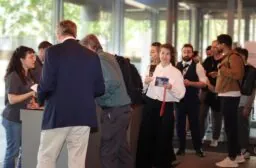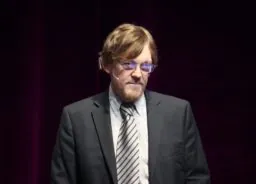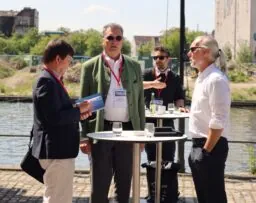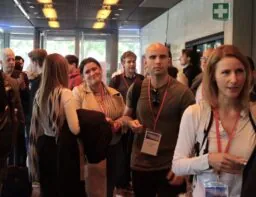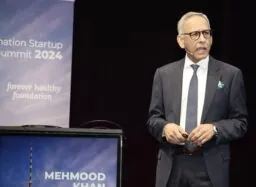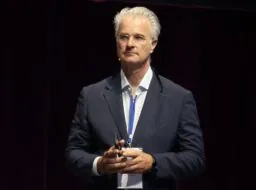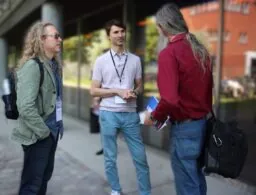For our readers in the Northern Hemisphere, the summer has begun! The weather isn’t the only thing heating up, as we have been busy advocating for research on aging!
Lifespan.io at the Rejuvenation Startup Summit
The Lifespan.io team was recently at the Rejuvenation Startup Summit in Berlin hosted by the Forever Healthy Foundation. This is one of the most important events on the longevity calendar, and several of us attended.
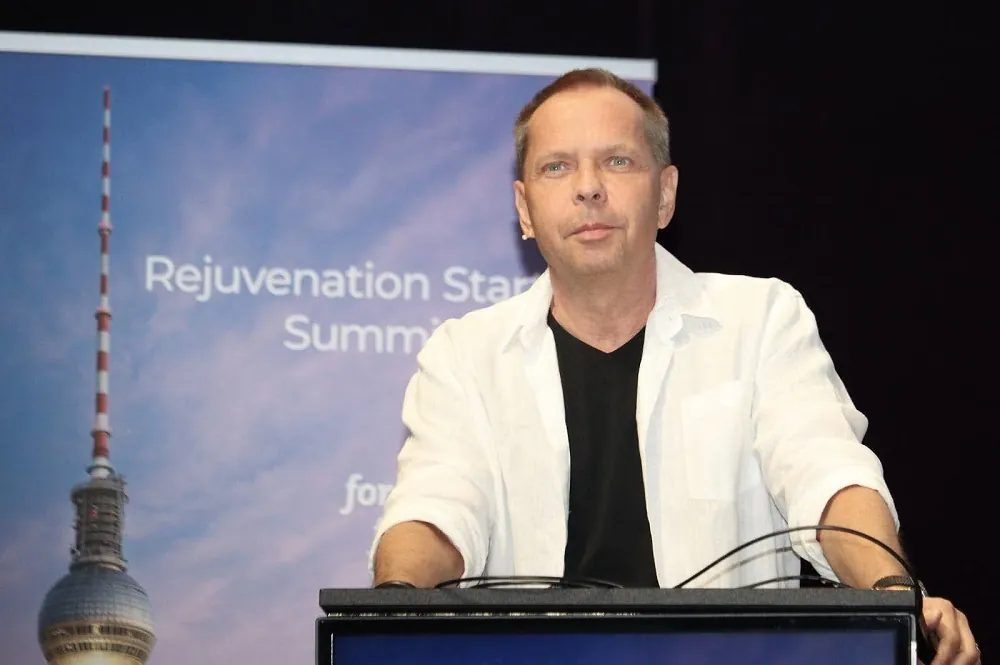
Michael Greve from the Forever Healthy Foundation giving the opening talk.
Building the largest industry in human history
This event aimed to support the growth of rejuvenation biotechnology to become the biggest industry in human history.
This is not an exaggeration; everyone ages and suffers from age-related diseases. There will be a huge market for treatments that help people stay biologically younger and prevent such diseases. Potentially, every single human being on the planet is a customer.
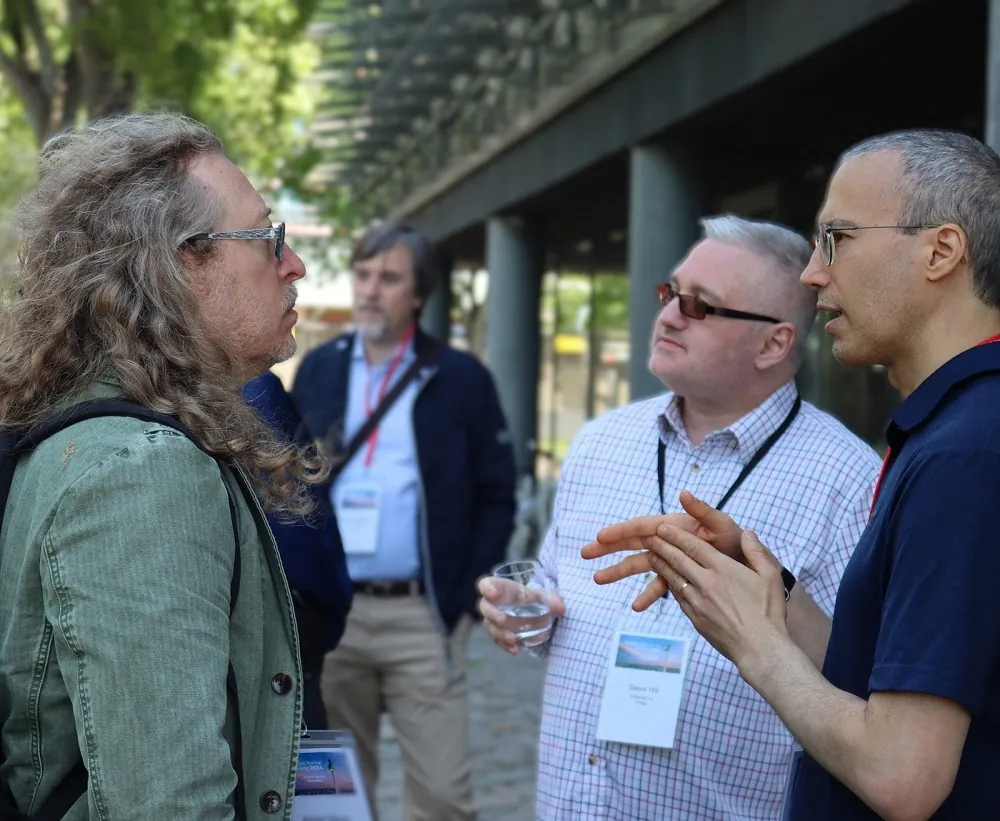
Lifespan.io’s Steve Hill and Arkadi Mazin with David Barzilai aka Agingdoc.
We are at a point in our field’s history when there are a number of therapies either in or near human clinical trials. All it will take is for one of those to succeed. Demonstrating that rejuvenation is possible and that aging can be slowed, halted, or even reversed will be a game changer.
That is the point at which wider public interest and attention should happen. The conversation will then turn to the potential of tackling aging, rather than reasons not to. More and more investment should then happen, and the pace of progress could snowball.
Conferences like the Rejuvenation Startup Summit are critical in helping science to reach this point.
A few years ago, the biggest bottleneck to progress was the lack of funding for preclinical research. Things have progressed since then, and getting therapies to clinical trials is now the bottleneck.
Moving from funding preclinical research to clinical trials is a big step, and this is where investors come in.
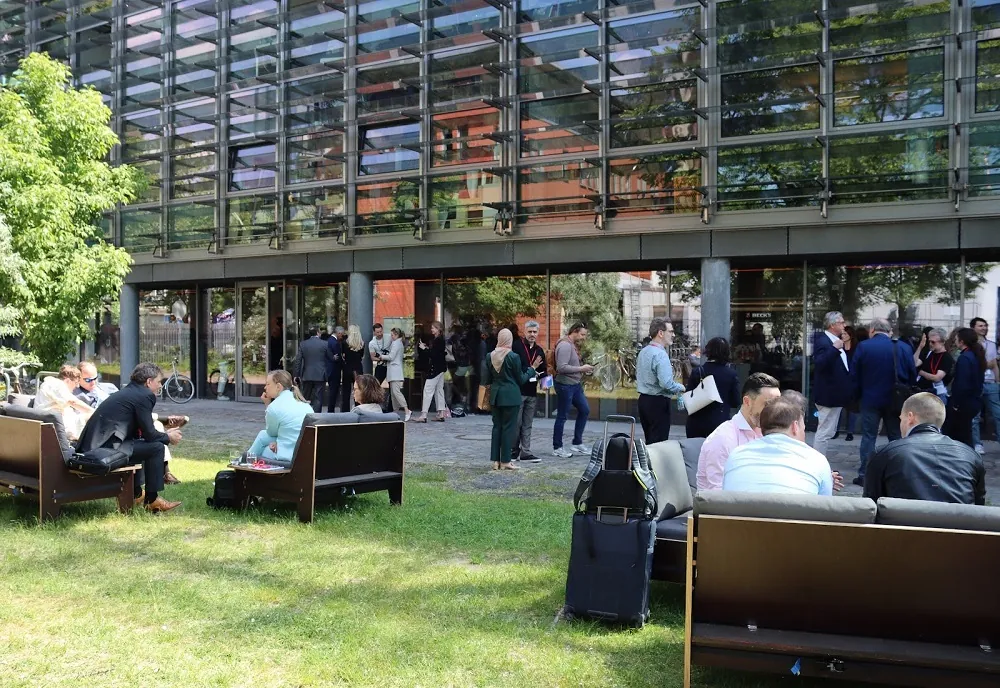
The riverside venue was packed with researchers, investors, and longevity advocates.
Many new biotech companies presented at the conference, and it was a good chance to meet and connect with others. There is no doubt that many deals resulted from the event, and this is the fuel that drives progress towards the clinic.
For more insights from the conference, check out “Everything Happens in Berlin”: Highlights from the Summit by Arkadi Mazin.
Effective communication for aging and longevity research
Stephanie Dainow, Lifespan.io’s Executive Director, gave a talk at the Rejuvenation Startup Summit. The talk focused on how to effectively communicate with investors, policymakers, and the public about rejuvenation biotechnology.
This is critically important if we want to continue to generate interest and support among the general public.
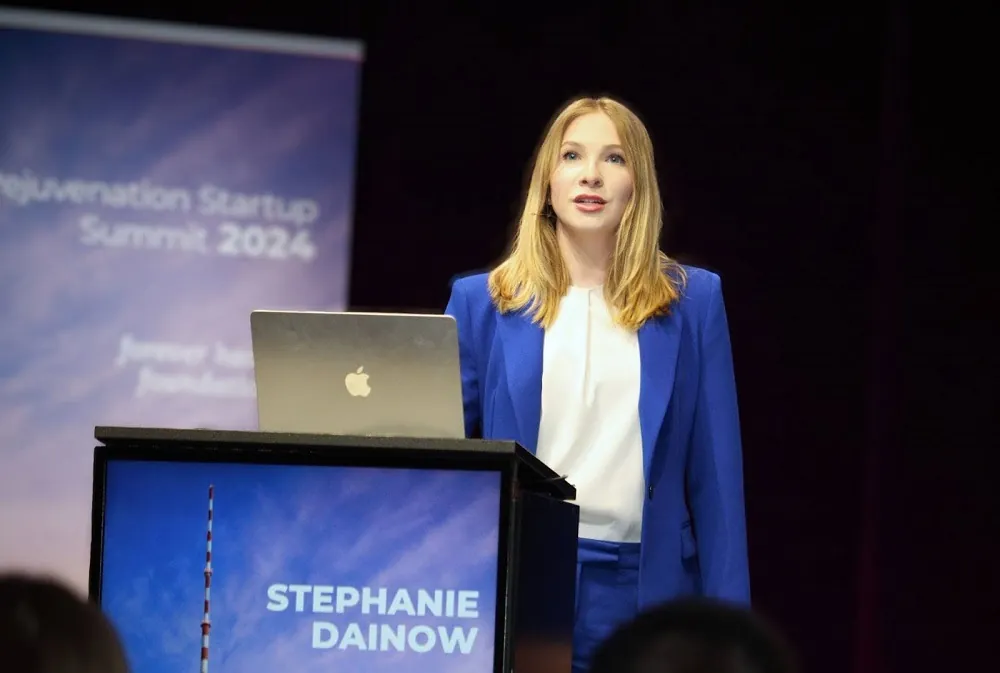
Lifespan.io’s Stephanie Dainow talks about the importance of effective communication.
Unfortunately, many researchers have difficulty communicating what they do to people without scientific backgrounds in a way that these interested people can understand. Talking with other academics is easy enough, but it can be difficult to discuss this science with people who have different fields of expertise.
To overcome what is perceived to be the biggest bottleneck to progress in the longevity field, namely, lack of funding, we need to find more effective ways to communicate. In fact, ineffective communication itself, Dainow argued, is the real bottleneck.
People have different levels of understanding of this topic, so we must adjust how we communicate to fit the audience. We shouldn’t assume that they will automatically understand, especially when discussing complicated biology. This is a common mistake, and it’s where we can often lose people’s interest.
Our approach to communication has three key points:
- Find common ground
- Meet them where they are
- Choice of language matters
Find common ground
When you care about a cause, it’s easy to come out all guns blazing against anyone with a differing opinion, but this is counterproductive in the long run.
Misconceptions and resistance to the idea of longevity come from deeply-rooted beliefs and the fear of the unknown. However, the potential benefits and opportunities for a healthier and longer life are becoming increasingly tangible.
Instead of attacking someone’s core beliefs head-on and trying to change their mind, try to find common ground instead. This starting point should be something that is very compelling and undeniable. Ideally, it will be something that has a similar “fact of life” sense of permanence to it that the other person’s core beliefs have.
Something that people will generally accept is that aging leads to a gradual failure of bodily systems, frailty, and disease. This is an undeniable reality for everyone and is the truth that most of us accept. It is an inevitable consequence of living and a biological reality, and there is no argument against it.
Plus, we all understand what it feels like when our bodies aren’t working. After all, we have all experienced being sick or injured during our lives, and we know how bad that feels. Therefore, we can leverage this mutual understanding, which makes it possible to talk about rejuvenation biotechnology in the context of reducing suffering.
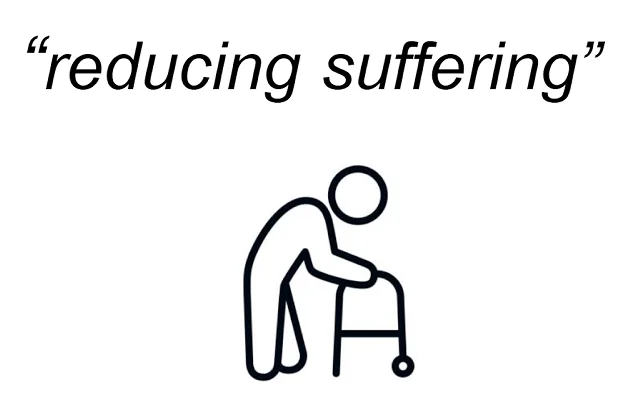
Aging leads to age-related diseases that cause suffering, and suffering is bad. No one in their right mind would argue that suffering is a positive thing or that it makes us happy. It is hard to argue against the idea that less suffering and more happiness are good and desirable things.
It’s also important to remember that it’s not just about solving a problem you think is important. It’s about making them see that your problem is also their problem and that they will benefit from you solving it.
Meet them where they are
If you want the wider public and people outside the field to engage with this topic, understand where they are and meet them there. Taking them on a journey that they personally relate to personally is a great way to do this.
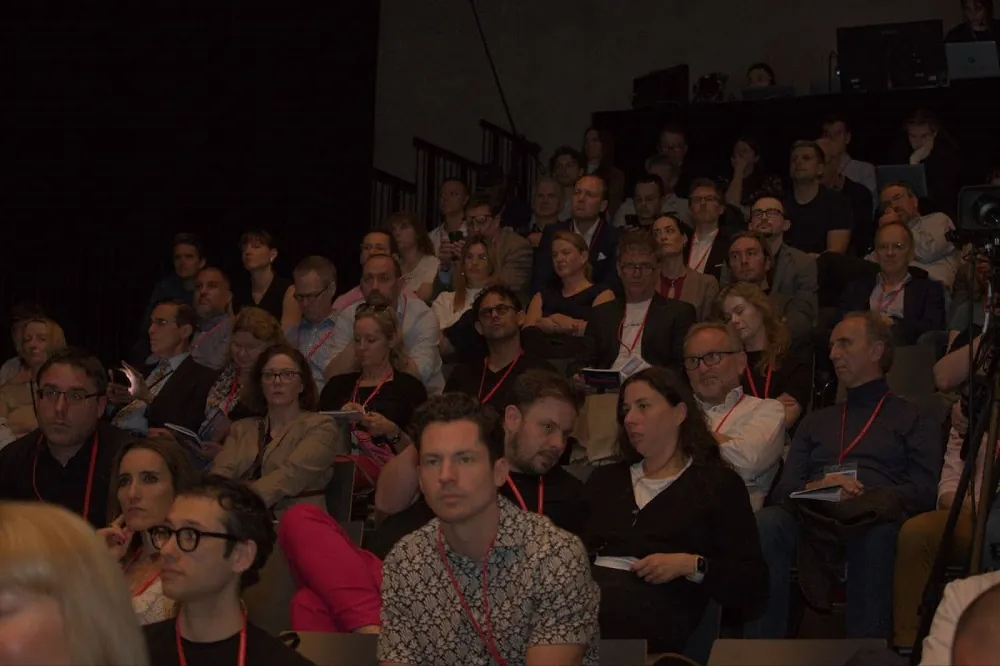
Audiences may not be as engaged as those at the Rejuvenation Startup Summit, so plan accordingly.
Therefore, understand your audience, particularly their knowledge level, before jumping into the science of rejuvenation biotechnology. While talking, pause and ask if they understand or need a different explanation. You can also go back to a broader overview if needed. After all, anyone who does not understand what you are talking about will become confused and disinterested.
Stephanie gave an example of where failing to take the audience on a shared journey cost the presenter funding. At an event, a scientist talked about their research and company in order to seek funds.
In the audience were several high-net-worth individuals who listened and nodded as the speaker gave their presentation. Unfortunately for the presenter, the nodding was a pretense, and no one really understood what was being said.
Afterwards, Stephanie asked some of these people what they thought of the talk. The answer was not positive. They said that their heads were spinning trying to understand what was being said, and it made them uncomfortable.
When she asked if they would consider investing in the startup or other longevity projects, the answer was no. They believed that even if what was being said was real, it was not their area of expertise and understanding, so they could not get involved.
This unfortunate reaction can be translated to: “I’m too overwhelmed to be excited about learning more. I don’t understand it, and I don’t understand what the scientist was trying to explain.” Their perception of anything longevity-related is now tainted by this single experience. The idea has been rejected and any potential funding along with it.
So, lighten up, connect with the listener, and make sure you are both on the same page.
Choice of language matters
Your particular choice of words when talking about rejuvenation biotech is important. A wide range of people are interested in aging and rejuvenation research for different reasons.
Some people may be approaching the field from the wellness side, which makes them interested in learning about what can be done now to extend healthy life. Others may have a sick or elderly relative, so they’re looking for information about battling specific diseases or conditions. Others still may be motivated by a desire to use their resources to make the world a better place, which has put them on the search for philanthropic opportunities.
Whatever your own reason for supporting the research being done, take a look at this word cloud:
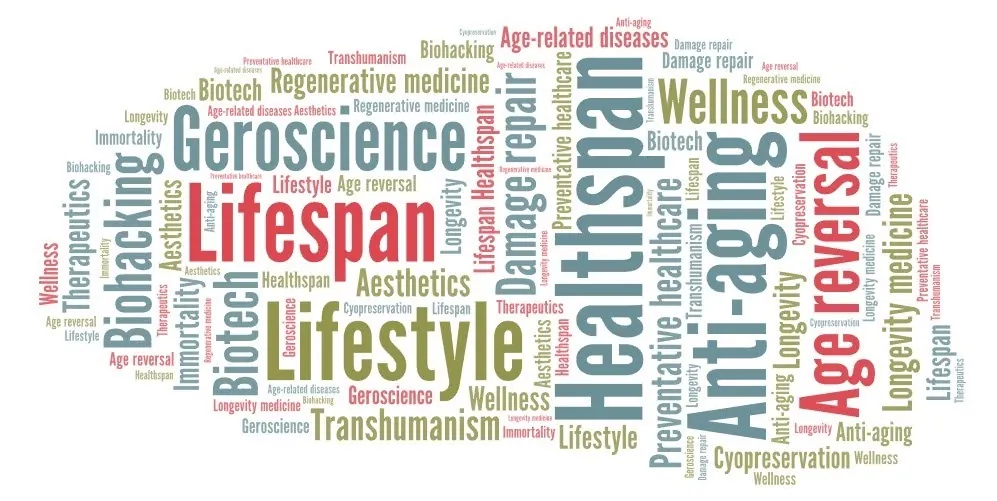
As you go through this list, pay attention to how you think and feel about each word.
When speaking with others, make an effort to understand their perspective. Choose words from this list that align with your audience. This will help them understand your message.
Be curious about your audience, find out what motivates them, and use that to frame how and what you are saying. This makes the conversation relatable and will help them to stay engaged with what you are talking about.
For example, if your audience is interested in maintaining good health, consider discussing preventative healthcare or damage repair. However, if they are passionate about organic products and yoga, the term ‘wellness’ may resonate. A medical doctor will understand the terms ‘regenerative medicine’ and ‘geroscience’. For individuals focused on maintaining youth and appearance, consider using the term ‘anti-aging’.
Above all, remember: communication matters just as much as the science.
Moving forward together for aging research
The Rejuvenation Startup Summit was also a great opportunity for the Lifespan.io and SENS Research Foundation teams to get together.
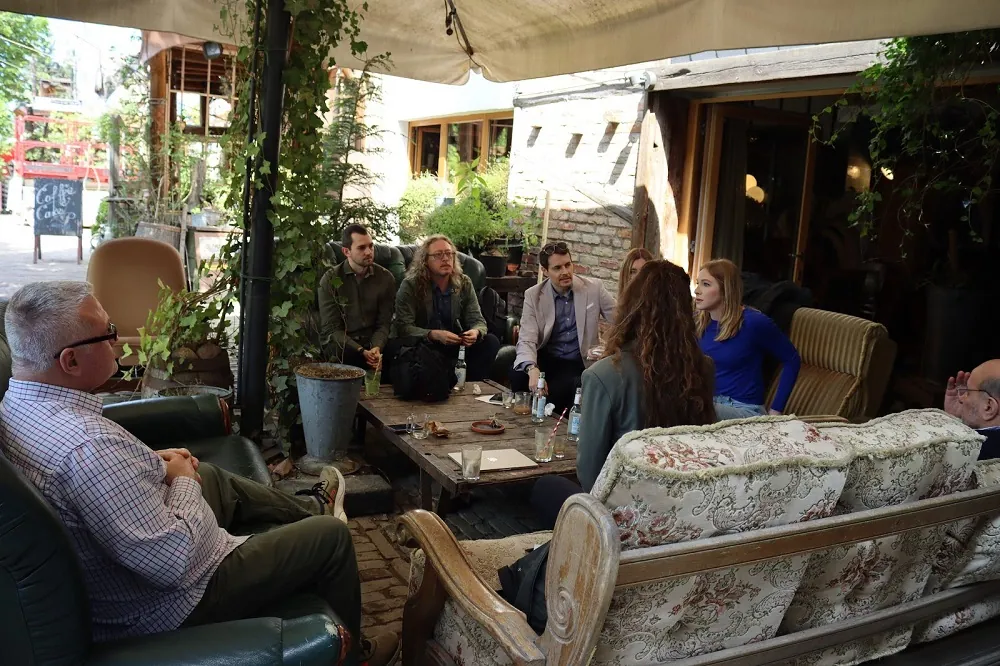
The Lifespan.io and the SENS Research Foundation teams meet over breakfast.
From Lifespan.io, we had Stephanie Dainow, executive director; Steve Hill, editor-in-chief; Christie Sacco, brand manager; Arkadi Mazin, journalist; and Paul Spiegel, board member. Representing SENS Research Foundation were Maria Entraigues Abramson, director of development; James Hale, associate director of partnerships; and Gary Abramson, creative & web lead.
In April, Lifespan.io and the SENS Research Foundation announced their intention to merge and form a new longevity entity. We will have more news to share about what the two organizations will be doing to drive progress in aging research in the future.
Last but not least, many thanks to Lifespan.io volunteer, Fatima Hill, for being our official photographer. We have a gallery of photos from the event for you to enjoy below.
Please feel free to post them on social media and mention the Lifespan.io Facebook, Lifespan.io Twitter, or Lifespan.io Linkedin pages. If you do, we’d love to see your posts.
Walking the walk at 0100 Conference Europe
In March, Stephanie Dainow, Lifespan.io Executive Director, joined a panel at 0100 Conference in Amsterdam.
When it comes to longevity, you may talk to the talk, but can you walk the walk? Five panelists accepted the challenge! They took to the treadmills while having a discussion about the developing longevity tech industry.
Walking is a great activity for anyone serious about longevity.
The treadmills symbolize the determination needed to navigate long-term investments. They also represent the ability to create opportunities that can enhance our health. Additionally, exercise may help increase our lifespan by several years or more.
The panelists were:
- Bill Liao from SOSV
- Marc P. Bernegger from Maximon
- Alex Colville from age1
- Amol Sarva from LifeX Ventures
- Stephanie Dainow from Lifespan.io
The panelists discussed the importance of exercise, age reversal therapies, and the opportunities in this growing field. They also addressed misconceptions and the potential impact on society and resources.
Key insights from the panel
- Age-reversal interventions are becoming a reality through advancements in biotech.
- Mental health and neurodegenerative disorders are also important aspects of longevity.
- The field of longevity has gained mainstream attention and is supported by nonprofits, advocacy groups, and the media. This increased visibility has accelerated progress in the field.
- The financial upside of longevity investments is substantial, with projections of a $200 billion market for the first approved aging drug. The field offers opportunities for both therapeutics and related industries.
- Longevity investments can have a positive impact on resource consumption, as healthier, longer-lived individuals require fewer resources and contribute to a more sustainable society.
- The convergence of technology, such as AI and big data, with advancements in biology and medicine is accelerating progress in the field of longevity and opening up new possibilities for interventions and treatments.
- The focus on reducing suffering and improving quality of life through interventions that address age-related diseases, mental health, and overall well-being is at the core of the longevity field.
Lifespan.io at the 2024 SALT conference
Lifespan.io Executive Director, Stephanie Dainow hosted a panel at the SALT iConnections New York 2024 conference.
Stephanie Dainow hosts the Breakthroughs in Longevity panel.
The panel was titled “Breakthroughs in Longevity: How Programmable Biology is Helping Humans Live Healthier, Longer”. The panelists were:
- Stephanie Dainow – Executive Director, Lifespan.io
- Stephen Berenson – Managing Partner, Flagship Pioneering
- Nir Barzilai – President, Academy for Health and Lifespan Research (AHLR)
- Jeff Huber – Co-Founder & General Partner, Triatomic Capital
- Abby Miller Levy – Managing Partner & Co-Founder, Primetime Partners
SALT is a global thought leadership forum and capital introduction platform encompassing finance, tech & public policy. It is comprised of a community of the world’s foremost investors, creators and thinkers.

The Breakthroughs in Longevity panelists.
Here’s to more connections, deeper discussion, and bigger and better communication for longevity.
Events like this help us to be a powerful force for longevity research, advocacy, journalism, and education! If you are interested in supporting us, please consider making a donation to our non-profit organization.


